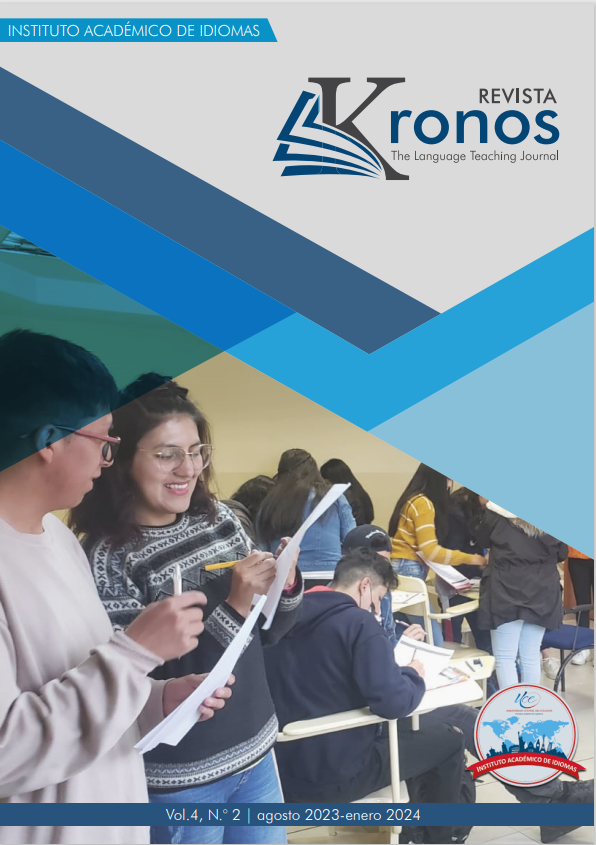Influencia de la administración de aula en la adquisición del inglés con estudiantes EFL A2
DOI:
https://doi.org/10.29166/kronos.v4i2.4702Palabras clave:
Motivación, gestión de tiempo, toma de decisiones, diseño físicoResumen
El objetivo de este artículo es analizar cómo la administración de aula influye en la adquisición del nivel del
idioma inglés A2 por medio de una nueva metodología de gestión académica. La pertinencia del estudio radica en el
número de estudiantes que no alcanzan la certificación de conocimientos y destrezas a través de la aplicación de la prueba estandarizada A2 Key (KET). La presente investigación está realizada sobre una base constructivista que genera la reestructuración cognitiva, al integrar conocimientos nuevos y modificar los preexistentes. Asimismo, se ha utilizado el método de aprendizaje conocido como Suggestopedia, que demanda de una óptima y permanente comunicación entre el educador y los alumnos. Este conjunto de técnicas permite también la implementación de varios componentes artísticos
en el aula, logrando de este modo mayor interacción y mejor desempeño de los estudiantes. El estudio posee una metodología de investigación cuasiexperimental con la participación de dos grupos seleccionados de manera aleatoria: uno experimental y otro de control. Finalmente, utilizando un diseño de pre y postest se establece la diferencia en el desarrollo de destrezas alcanzadas en cada grupo, donde los resultados apuntan a la necesidad de un modelo de gestión de aula con elementos como motivación, gerencia de tiempo y diseño físico.
Descargas
Citas
Castro, O. D., & López, C. L. (2009). Evaluación educativa. Los nuevos retos. Gráficas Ruiz.
Celce-Murcia, M., Dörnyei, Z., & Thurrell, S. (1997). Direct Approaches in l2 Instruction: A Turning Point in Communicative Language Teaching? tesol Quarterly, 31(1), 141-149. DOI: https://doi.org/10.2307/3587979
Freeman, D. E., & Freeman, Y. S. (2008). Essential Linguistics. Heinemann.
Harmer, J. (2009). How to teach English. Pearson Longman.
Herrera, S. G. (2010). Biography-driven culturally responsive teaching. Teachers College Press.
Herrera, S. G., Kavimandan, S. K., & Holmes, M. A. (2011). Crossing the vocabulary bridge.
Teachers College Press.
Herrera, S. G., & Murry, K. G. (2015). Mastering esl and Bilingual Methods. Pearson Education, Inc.
Iglesias, M. L. (2012). Observación y evaluación del ambiente de aprendizaje en educación
infantil: dimensiones y variables a considerar. Retrieved from: https://rieoei.org/RIE/
article/iew/704
Kort, B. & Reilly, R. (2001). Evolving educational pedagogy in developing nations. Digital
Nations Symposium at the mit Media Lab, 1-8.
Ministerio de Educación de Guatemala (2013). Manual del aula de calidad. Ciudad de
Guatemala, Guatemala: mineduc.
Nation, I. S. P. (2001). Learning vocabulary in another language. Cambridge University DOI: https://doi.org/10.1017/CBO9781139524759
Press.
Oliver, R., & Reschly, D. (2007). Effective Classroom Management: Teacher Preparation and
Professional Development. National Comprehensive Center for Teacher Quality.
Palenzuela, M. (2012). Inteligencias múltiples y aprendizaje del inglés en el aula de adultos
mayores. Editorial Universidad de Almería.
Pizarro, G., & Josephy, D. (2010). El efecto del filtro afectivo en el aprendizaje de una
segunda lengua. Letras, 48, 209-225.
Richards, J., & Rodgers, T. (2001). Approaches and methods in language teaching: A description DOI: https://doi.org/10.1017/CBO9780511667305
and analysis. Cambridge University Press.
Rodríguez, J. (2014). Nuevas metodologías didácticas. Editorial acci.
Rubin, J. (2005). The Expert Language Learner: A Review of Good Language Learner DOI: https://doi.org/10.1057/9780230523470_3
Studies and Learner Strategies. Expertise in Second Language Learning and Teaching,
-31.
Saumell, C., Alsina, G., & Arroyo, A. (2011). Alumnado con dificultades de regulación del
comportamiento. Editorial graó.
Vaello, J. (2003). Resolución de conflictos en el aula. Santillana Educación.
Vásconez, B. E. (2012). Guía didáctica para mejorar las destrezas productivas del idioma inglés
dirigida a los cadetes de segundo curso de la Escuela Superior Militar Eloy Alfaro. Universidad Tecnológica América, Quito, Ecuador.
Vásconez, B. E., & Verdezoto, J. E. (2007). The incidence of the English Language Learning
on the Ecuadorian Cultural Educational Context at Manuel Abad High School, 10th year
of Basic Education, School Year 2006-2007. Universidad de las Fuerzas Armadas-espe,
Quito, Ecuador.
Villalobos, X. (2011). Reflexión en torno a la gestión de aula y a la mejora en los procesos de
enseñanza y aprendizajes. Revista Iberoamericana de Educación
Publicado
Cómo citar
Número
Sección
Licencia
Derechos de autor 2023 Boris Vasconez Torres

Esta obra está bajo una licencia internacional Creative Commons Atribución-NoComercial-CompartirIgual 4.0.












